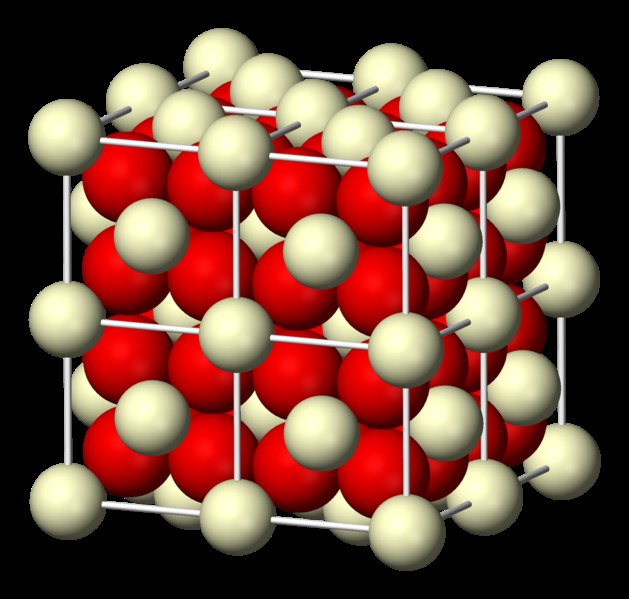Barium Titanate Nanoparticles and Barium Titanate Nanopowder Applications
Barium Titanate Properties

Barium Titanate is a white colored inorganic chemical compound with the chemical formula BaTiO3. It was discovered in 1945 and because
of its mechanical and chemical stability and good electrical properties
a lot of research have done on this chemical.
Barium Titanate has a cubic structure and it is a member of a large group of compounds with general formula ABO3
which is called the perovskite family and it is the first discovered ferroelectric perovskite.
Nanoparticles of Barium Titanate and the Application Areas

There are many important application areas where Barium Titanate nanoparticles can be used. Since Barium titanate exhibits ferroelectric properties it is an excellent photorefractive material. Barium Titanate nanoparticles show high density optical data storage. This property of Barium Titanate Nanoparticles makes them useful in optical computing, optical image processing, piezoelectric devices, pyroelectric sensors, lasers, nonlinear optical devices, pattern recognition, dielectric amplifiers, and other optoelectronic devices. Barium Titanate Nanoparticles also can be used in multifunctional structural capacitors.
Technical Properties of our BaTiO3(Barium Titanate) Nanoparticles, 99.95%, 45nm, Cubic product
| Purity % | 99.95 |
| Color | white |
| AVERAGE PARTICLE SIZE (nm): | 45 |
| Specific Surface Area (m2/g) | .20.50 |
| True Density (g/cm3) | .5.90 |
| Crystallinity | cubic |
| Morphology | spherical |
| Ba/Ti | 1.00 |
You may find BaTiO3(Barium Titanate) Nanoparticles, 99.95%, 45nm, Cubic by clicking the link below:
Technical Properties of our BaTiO3(Barium Titanate) Nanoparticles, 99.95%, 370nm, Tetragonal product
| Purity % | 99.95 |
| Color | white |
| AVERAGE PARTICLE SIZE (nm): | 370 |
| Specific Surface Area (m2/g) | .2.80 |
| True Density (g/cm3) | .5.90 |
| Crystallinity | tetragonal |
| Morphology | spherical |
| Ba/Ti | 1.00 |
You may find BaTiO3(Barium Titanate) Nanoparticles, 99.95%, 370nm, Tetragonal by clicking the link below:
Technical Properties of our BaTiO3(Barium Titanate) Nanoparticles, 99.95%, 90nm Cubic product
| Purity % | 99.95 |
| Color | white |
| AVERAGE PARTICLE SIZE (nm): | 90 |
| Specific Surface Area (m2/g) | .10.50 |
| True Density (g/cm3) | .5.90 |
| Crystallinity | cubic |
| Morphology | spherical |
| Ba/Ti | 1.00 |
You may find BaTiO3(Barium Titanate) Nanoparticles, 99.95%, 90nm Cubic by clicking the link below:
Technical Properties of our BaTiO3(Barium Titanate) Nanoparticles, 99.95%, 280nm, Tetragonal product
| Purity % | 99.95 |
| Color | white |
| AVERAGE PARTICLE SIZE (nm): | 280 |
| Specific Surface Area (m2/g) | .3.80 |
| True Density (g/cm3) | .5.90 |
| Crystallinity | tetragonal |
| Morphology | spherical |
| Ba/Ti | 1.00 |
You may find BaTiO3(Barium Titanate) Nanoparticles, 99.95%, 280nm, Tetragonal by clicking the link below:
Technical Properties of our BaTiO3(Barium Titanate) Nanoparticles,, 99.99%, Tetragonal, 500nm product
| Purity % | 99.99 |
| Color | white |
| AVERAGE PARTICLE SIZE (nm): | 500 |
| Specific Surface Area (m2/g) | .2.10 |
| True Density (g/cm3) | .5.90 |
| Crystallinity | tetragonal |
| Morphology | spherical |
| Ba/Ti | 1.00 |
You may find BaTiO3(Barium Titanate) Nanoparticles,, 99.99%, Tetragonal, 500nm by clicking the link below:
Technical Properties of our BaTiO3(Barium Titanate) Nanoparticles, 99.95%, 45nm, Cubic product
| Purity % | 99.95 |
| Color | white |
| AVERAGE PARTICLE SIZE (nm): | 45 |
| Specific Surface Area (m2/g) | .20.50 |
| True Density (g/cm3) | .5.90 |
| Crystallinity | cubic |
| Morphology | spherical |
| Ba/Ti | 1.00 |
You may find BaTiO3(Barium Titanate) Nanoparticles, 99.95%, 45nm, Cubic by clicking the link below:
https://nanografi.com/nanoparticles/batio3-barium-titanate-nanoparticles-99-95-45nm-cubic/
Comments
Post a Comment